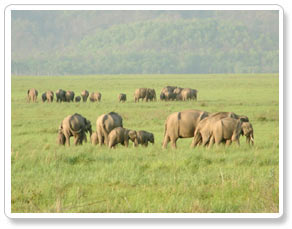
You Are Here :: Golden Triangle Tours India :: Wildlife Tourism :: Corbett National Park
Corbett National Park
 The National park : Corbett was the first National Park to be incorporated in the Project Tiger scheme, in 1973. Today Corbett National Park and Tiger Reserve sprawls over an area of 1318 square kilometers (510 square miles) of undulating Sal (Shorea robusta) forest between the districts of Nainital and Pauri Garhwal in Uttar Pradesh, in northern India. In October 1991, a buffer zone was added to the park's area, consisting of just over 300 square kilometers (117 square miles). The additional expanses of natural land used to form part of the Klagarh Forest Division, the Sonanadi Wildlife Sanctuary (part of the Ramanagarh Forest Division). The newly created park with its adjoining verdant acres today make up the sole surviving jungles of the Garhwal Himalaya
The National park : Corbett was the first National Park to be incorporated in the Project Tiger scheme, in 1973. Today Corbett National Park and Tiger Reserve sprawls over an area of 1318 square kilometers (510 square miles) of undulating Sal (Shorea robusta) forest between the districts of Nainital and Pauri Garhwal in Uttar Pradesh, in northern India. In October 1991, a buffer zone was added to the park's area, consisting of just over 300 square kilometers (117 square miles). The additional expanses of natural land used to form part of the Klagarh Forest Division, the Sonanadi Wildlife Sanctuary (part of the Ramanagarh Forest Division). The newly created park with its adjoining verdant acres today make up the sole surviving jungles of the Garhwal HimalayaCorbett has aptly been described as the land of the Roar, Trumpet and Song. It represents a scene of remarkable beauty.
Corbett had the proud distinction of being the chosen venue for the inauguration of Project Tiger in India. The rich bio-diversity of the Reserve is partly attributed to the variety of habitat found here. Due to the location of the Reserve in the foothills of the Central Himalayas, both Himalayan and peninsular flora and fauna is found in the Reserve.
The grasslands, locally known as Chaurs, are limited. The largest grasslamnd is the Dhikala Chaur. Some of the best grasslands including the famous Buxor Chaur and the Beri Chaur were submerged in the Ramganga reservoir in 1974. The areas made available as a result of the relocation of the villages, Dhara, Jhirna and Kothirau in 1994 are being developed into grasslands through habitat management.
Location of Corbett National Park : Situated at an altitude of 120 and 400m (400 and 1250ft). Nearest railhead is at Ramnagar, approximately 19km (12 miles) southeast of the park. Nearest airport is at Pantnagar 50km (30 miles) away.
Climate of Corbett National Park : Summer temperatures soar to 43°C (108°F) at max and 19°C ( 42.5°F) at Min., while on winter day temperature rises to 25°C (46°F) and dips to 3°C (33°F) .
When to go (Best Time To Visit Corbett National Park) : Best period is between November and May; visibility of wildlife is better in the drier summer. Park remains closed in wet monsoon season from July to October.
Getting to Corbett National Park : The Delhi-Moradabad National Highway connects the Kashipur-Ramnagar-Dhikala network of towns. Project Tiger headquarters are at Ramnagar, mandatory entry point for the park. Bus services operate regularly along the Nainital-Kathgodam-Ramganagar-Dhikala route.
Facilities at Corbett National Park: Basic facilities at Dhikala (forest rest houses and log huts), which has a canteen and shop selling provisions. Forest rest houses at Sarapdull, Gairal and Bijrani, all within the park. More up market hotels in nearby Ramnagar; Corbett Infinity Resort (Tiger Tops), Corbett River Side Resort are good to relax.
Reservation for Corbett National Park : Contact : The Field Director, Poject Tiger, Corbett Tiger Reserve, Post Office; Ramnagar, Nainital District, Uttranchal
Conservation History
The Reserve area was named as 'Hailey National Park' in 1936. This was renamed in 1954-55 as 'Ramganga National Park' and again in 1955-56 as 'Corbett National Park'. Its the oldest National Park of India. It was one of the nine Tiger Reserves created at the launch of the Project Tiger in 1973. The original area of the Park was 323.75 sq. km. to which 197.07 sq. km. was added later. An area of 797.72 sq. km. was added as buffer of the Corbett Tiger Reserve in 1991. This area includes the whole of Kalagarh Forest Division (including 301.18 sq. km. area of Sonanadi Wildlife Sanctuary), 96.70 sq. km. of Ramnagar Forest Division and 89 sq. km. The administrative control over the entire area is that of the Field Director of the Reserve.
Forest Types
Northern Moist Deciduous, Northern Tropical Dry Deciduous, Himalayan Subtropical Pine Forests
Main Species(Flora)
Sal, Khair, Sissoo, Ber, Kuthber, Bel, Chbilla, Dhak, Semal, Khingan, Kharpat, Rohini, Bakli, Pula and Bamboo
Main Species(Fauna)
Mammals: Tiger, Leopard, Elephant, Cheetal, Sambar, Hog Deer, Barking Deer, Wildboar Langoor And Rhesus Monkey.
Birds : Peacock, Jungle Fowl, Partridges, Kaleej, Crow, Vulture, Parakeets, Laughing Thrush, Orioles, King Fishers, Drongo, Doves, Woodpeckers, Ducks, Teals, Storks, Cormorants and Seagulls .
Reptile : Indian Marsh Crocodiles Or Mugger, Gharials, King Cobra, Common Krait, Cobra, Russel, Python and Monitor Lizard.
Pisces : Mahaseer, Kalimuchi, Kalabasu, Chilwa and Goonch.

 Attraction in Agra
Attraction in Agra Attraction in Jaipur
Attraction in Jaipur  Attraction in Delhi
Attraction in Delhi